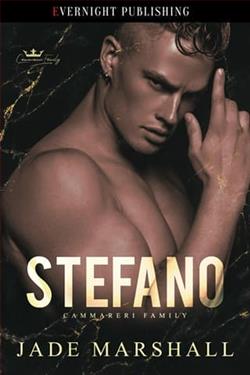Page 11 of His Tempting Duchess
Daphne threw a wry smile over her shoulder. “Come on, you know me by now. I don’tlikeart. I’m here to see one painting and one alone.”
“And you paid the entrance feeandbought a brochure for just one painting?” Emily commented. “Not exactly a bargain, is it?”
Daphne only smiled faintly, scanning the rows of pictures. “Worth every penny.”
They entered a large, circular room at the very center of the gallery. There were fewer paintings here, but more people gathered around them. A high glass dome let in plenty of light, and the white walls reflected the sunlight and gave the place an almost ethereal glow.
“There!” Daphne whispered, pointing. “There it is.”
Emily’s breath seemed to catch in her throat. A crowd of six people had gathered in front of a large painting. Unlike the others, it was a round canvas, ringed by a simple gilt frame. It gave the impression of looking through a window. There was the round window pane, swinging back and almost out of sight. A circle within a circle. Edges of a brick wall could be seen around the window, but one’s focus was drawn to the woman in the center of it all.
She was dressed a little strangely, in a high-necked gown with hardly any hoop underneath and puffed sleeves at the shoulders, her hair piled in a knot atop her head. Tendrils fell untidily around her face. A wide-brimmed straw hat hung loosely from her fingers. She was only half-turned towards the window and stood in a garden.
It was a pleasant garden, well-maintained, although a riot of birds fluttered above a hedge in the background, and a pair of abandoned, rusty shears sat in the grass by the woman’s feet. There was a basket of flowers, too, almost out of view at the edge of the window.
The woman was not the ethereal beauty found in other paintings. Her hair was drab brown, her eyes grey, her face uncompelling. What truly grabbed one’s attention, however, was her expression.
Daphne, bold as always, used her elbows and her glare to get them both to the front of the crowd. When they reached it, she withdrew the brochure and began to read.
“Woman In The Window. Another classic painting from the mysterious artist who identifies himself only as ‘Anon.’ This scene initially gives viewers the impression of domestic bliss and contented womanhood. Or does it? On closer inspection, the woman’s face is not a vision of loveliness but bears an expression of anger, betrayal, and determination. One might notice that the flowers in the basket are wilted, the birds in the background are fighting, and the abandoned pruning shears have stains on them which caused something of a scandal upon the painting’s initial release, with some viewers claiming that the shears were, in fact, bloodied.
“Woman In The Window has proved popular with female art connoisseurs, with ladies leaving the scene reporting feelings of energy and determination, even a sense of injustice. They found themselves pondering questions such as, what has this Woman done? Or more to the point, what is she going to do?
“Gentlemen, however, have mostly complained that the primary figure is rather plain and wears old-fashioned clothing. As always, this submission is a thought-provoking work of art from the ever-enigmatic Anon, a gentleman we can only hope will reveal his identity to the Fashionable World very soon.”
Daphne finished reading, glancing up at the painting again.
“It’s beautiful,” she murmured, quiet enough so that only Emily could hear. “Your best work.”
Emily allowed herself a small smile.Woman In The Windowhad not taken her very long. She’d gotten the idea for the sketch only a few days after her failed wedding, and the painting itself took shape rapidly.
Despite her anonymous status, she was able to receive payment for her work. It was never a great deal before, butWoman In The Windowwas immensely popular. Already, her agent was pressuring her to produce another. He, like the rest of London, assumed that she was a man, even though he addressed his letters to a post office in the center of London, to one ‘Anon Smith.’
Daphne slid her arm through Emily’s, squeezing tight.
“It’s breathtaking,” she murmured. “Edward wants to see it, and so does Alex. Anna and Theo have already been to see it three times, you know. I do so wish I could tell people that mysisteris the one who painted the picture that is taking London by storm.”
“Maybe one day,” Emily sighed. “But I think that if people knew that their favorite painting was done by an uninteresting miss, they’d stop being interested. I would lose everything.”
“I know, I know. But things might change.”
Emily doubted it, but Daphne looked so hopeful that she only smiled and nodded.
The crowd began to thin. It was only temporary, of course—a large group of people had entered the previous rooms, and would soon filter through here.
“He never contacted me again,” Emily blurted out, not sure where the thought had come from.
Daphne glanced at her, arching an eyebrow. “What did you say?”
Emily sighed. “You kept asking about me and the Duke of Clapton. I was cagey about it and only said that everything was taken care of. Well, all that happened was that he didn’t contact me. Not a visit or a letter—not even a note. After I left the church, I never saw him again.”
Daphne was silent. “So, you think he’s forgotten about you?”
“He must have.”
She sighed. “Well, I’m sorry to burst your bubble, Sister, but I don’t think so.”
“Why not?”















